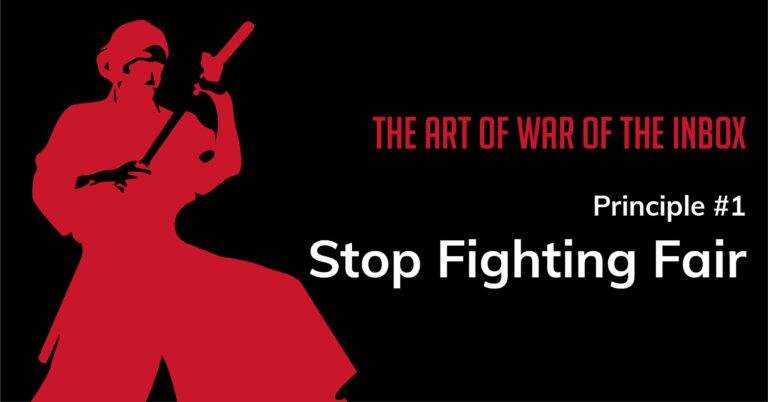“According as circumstances are favorable, one should modify one’s plans.”
Sun Tzu
Your email inbox has become a warzone. And when in times of war, wise generals – and marketers – should turn to Sun Tzu, the Chinese warrior-philosopher-strategist, for assistance. He documented his timeless advice in his now legendary guide, The Art of War.
The first principle we will extract and adapt from Sun Tzu is an idea woven through nearly every chapter of The Art of War. Stop. Fighting. Fair.
In email marketing, if you are playing on a level playing field with the same weapons as other companies, you should abandon the campaign or create an unfairly advantageous environment.
If the circumstances do not become favorable, do not launch the campaign.
Why Do We Fight Fair
When you hear the word fair, you may immediately think about fair play.
Like, don’t hit below the belt in boxing, don’t sucker punch someone at recess, or don’t cheat when playing poker with your Grandma. Our culture has taught us that the pursuit of fairness is a virtue. And this urge can help, especially when navigating social relationships and fitting into a community.
It makes sense to seek a fair exchange when dealing with allies. However, when dealing with your opponents in business, this same fairness can kill your campaigns – or business.
Fighting fair = best practices
“It is much easier to be fired for being illogical than it is for being unimaginative. The fatal issue is that logic always gets you to exactly the same place as your competitors.” Rory Sutherland
Conventional wisdom and what works in the real world can be radically different.
Playing it safe by adhering to conventional wisdom – or “best practices” – exposes you to the possibility that what worked for others won’t work for you. The moment a savvy opponent knows which best practice (or weapon) you’ll be deploying on a large campaign is when your opponent can make the fight “unfair” by pulling out a larger – or less kind – weapon onto the marketing battlefield.
Now, you can overcome this tendency to fairness by looking at these best practices as systems. When we look at system theory, we can break them down into four categories to help determine which may or may not help us win a campaign. They are …
• Simple Systems
• Complicated Systems
• Complex Systems
• And Chaotic Systems

● Simple systems are predictable best practices. (If this the situation is X, then always do Y, and consistently get a Z outcome)
● Complicated systems may have predictable outcomes but require execution by people with specialized, difficult-to-duplicate skills.
● Complex systems have emergent solutions – those which you can uncover through experimentation. Best guess a solution, design an experiment to pressure test it, run the experiment, rinse and repeat until you reach a favorable outcome.
Email marketing is not a simple system. It’s likely somewhere on the border between complicated and complex. As such, there are no best practices. In the best-case scenario, there are only good ones.
This ramble may sound like reinventing the wheel of email marketing is the only way to compete in the inbox. However, some simple reframing can help us navigate this chronic issue.
Playing Inside & Outside-the-box

What are the rules of email marketing? How do we know which ones can be bent – and which ones broken?
Ask yourself:
● What are the rules of this type of this email fight?
● And who sets them?
● Who enforces them?
● Which rules can be bent?
● Which can be broken?
● And with what consequences?
● And finally, who is my opponent in this fight – really?
In the email marketing war, two players hold the most influence: your prospect and your email provider. One can ignore you, allowing no space for a win. The other can filter or blacklist you, blocking access to the battlefield entirely.
Your enemy is rarely your business’ direct competitor. Prospects and email providers wield the most power in most email battles. Focus your strategic energies on beating – or bypassing – them.
Create an Unfair Competitive Advantage
Creativity may be the last unfair advantage we are legally allowed to have over the competition.
Bill Bernbach
Creativity may be one of the few legal competitive advantages you can regularly deploy in the email battle. You can …
● Use humor when your prospects are serious.
● Distill a complex topic into an easily digestible graphic or video
● Show your full humanness, bad grammar and all
● etc…
Be careful. Though the list is long, it is littered with stale fair fight practices that can fall flat with certain audiences or implode on certain email servers. And suppose you are in the rare situation of battling one of your competitors on the inbox battlefield. In that case, you may need to continually vary your tactics to stop them from anticipating and overcoming your overall strategies.
In our own business, the B2B Bandits, we’ve recently left the email battlefield entirely to create an unfair advantage.
Steal and adapt the useful bits. Don’t mimic and hope.
Stop fighting fair.
Resources/Links
- Farnam Street, Kantian Fairness Tendency: The World Isn’t Fair
- Rory Sutherland, Alchemy: The Surprising Power of Ideas That Don’t Make Sense
- Dave Snowden, The Cynefin Framework





